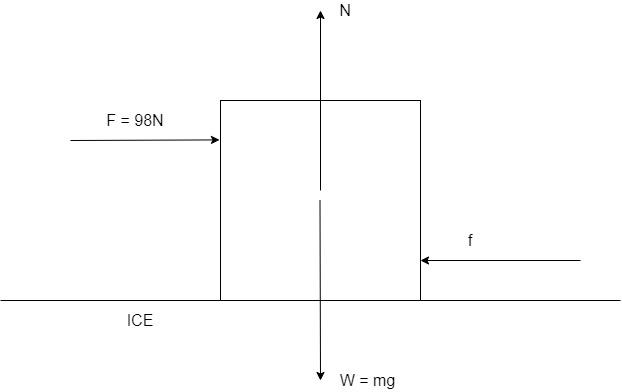
A force of 98 newtons is required to just drag a body of mass 100 kg on ice. The coefficient of friction will be
A. 0.98
B. 0.89
C. 0.49
D. 0.10
Answer
489.9k+ views
Hint: The friction basically means, a resistance or obstruction offered to the application of a force against another surface.
Mathematically, the frictional force is directly proportional to the normal reaction provided by the surface for the body.
Frictional force
By removing the sign of proportionality and introducing a constant, we have:
Where
Complete step by step answer:
Let us consider the body of mass 100 kg on ice

Here, there are 4 forces acting on the block. They are
i) Weight of the body,
ii) Normal force acted by the surface,
iii) Force applied to move,
iv) Frictional force,
Since the body just starts to move, the force applied to move the body is equal to the frictional force acting on it by the surface.
We see that the body is in equilibrium with all the forces acting on it. Hence,
Vertical forces:
Horizontal forces:
Given, mass m = 100 kg.
Weight,
This weight is equal to the normal:
Also, we have
Given,
Substituting the values of F and N, we have
Therefore, the coefficient of friction is,
Note:
The students should note that the force applied here, is equal to the kind of friction called impending friction. Impending friction is the friction applied to the body when the body is just about to start moving. Any applied force that is lesser than this particular value of impending friction, is termed as static friction.
Mathematically, the frictional force is directly proportional to the normal reaction provided by the surface for the body.
Frictional force
By removing the sign of proportionality and introducing a constant, we have:
Where
Complete step by step answer:
Let us consider the body of mass 100 kg on ice

Here, there are 4 forces acting on the block. They are
i) Weight of the body,
ii) Normal force acted by the surface,
iii) Force applied to move,
iv) Frictional force,
Since the body just starts to move, the force applied to move the body is equal to the frictional force acting on it by the surface.
We see that the body is in equilibrium with all the forces acting on it. Hence,
Vertical forces:
Horizontal forces:
Given, mass m = 100 kg.
Weight,
This weight is equal to the normal:
Also, we have
Given,
Substituting the values of F and N, we have
Therefore, the coefficient of friction is,
Note:
The students should note that the force applied here, is equal to the kind of friction called impending friction. Impending friction is the friction applied to the body when the body is just about to start moving. Any applied force that is lesser than this particular value of impending friction, is termed as static friction.
Latest Vedantu courses for you
Grade 11 Science PCM | CBSE | SCHOOL | English
CBSE (2025-26)
School Full course for CBSE students
₹41,848 per year
Recently Updated Pages
Master Class 9 General Knowledge: Engaging Questions & Answers for Success

Master Class 9 English: Engaging Questions & Answers for Success

Master Class 9 Science: Engaging Questions & Answers for Success

Master Class 9 Social Science: Engaging Questions & Answers for Success

Master Class 9 Maths: Engaging Questions & Answers for Success

Class 9 Question and Answer - Your Ultimate Solutions Guide

Trending doubts
State and prove Bernoullis theorem class 11 physics CBSE

Who built the Grand Trunk Road AChandragupta Maurya class 11 social science CBSE

1 ton equals to A 100 kg B 1000 kg C 10 kg D 10000 class 11 physics CBSE

State the laws of reflection of light

One Metric ton is equal to kg A 10000 B 1000 C 100 class 11 physics CBSE

Difference Between Prokaryotic Cells and Eukaryotic Cells




